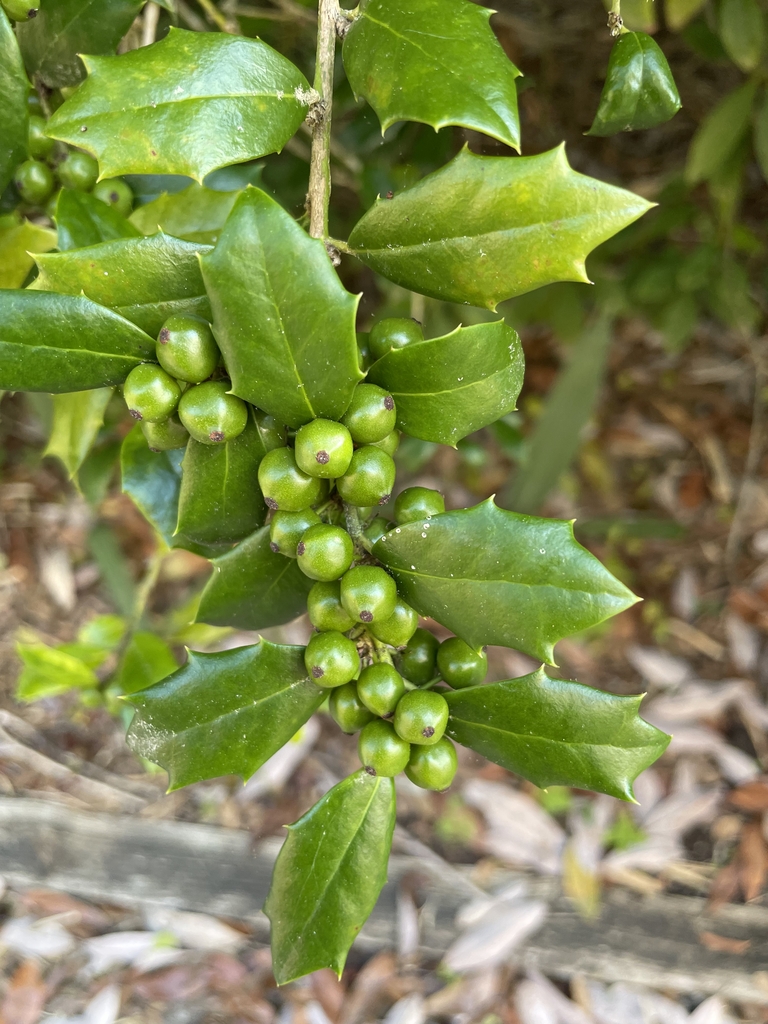Ilex x 'Carolina Sentinel'
Common Name(s):
- Phonetic Spelling
- EYE-leks
- This plant has low severity poison characteristics.
- See below
- Description
-
The Carolina Sentinel Holly is an Ilex cultivar resulting from a cross between I. verticillata and I. serrata. It has a narrow, dense and columnar form. For comparison, the form is more narrow and dense than the 'Nellie R. Stevens' cultivar. The Carolina Sentinel Holly is an evergreen shrub or small tree with leaves that are a deep green, almost a blue-green and inconspicuous white flowers. Female plants produce a heavy crop of red berries in the fall through the winter. The plant is dioecious (meaning individual flowers are either male or female, but only one sex is found on any one plant so both male and female plants must be grown if fruit is required). It is excellent for hedges, particularly in narrow spaces. It tolerates pruning and, in the landscape, can be grown as a hedge or trained to be a small tree. It is a JC Raulston Arboretum Selection.
This holly is tolerant of most soils except poorly-drained ones and can be grown in full to partial sun. It is tolerant of heat and humidity and is drought tolerant once established, making it a good choice for the south. Prune in the late winter to control its size if needed. The fruit and evergreen leaves make for winter interest in the landscape. The spiny leaves make this a good choice for a barrier as an impenetrable hedge. Mature plants do not tolerate root disturbance, so it is best to site the plant in its permanent position, preferably one that provides winter protection for the first year or two.
Diseases, Insect Pests, and Other Plant Problems:
No known diseases or pest issues. Depending on the planting location, this shrub can exhibit chlorosis, leaf drop, or leaf scorch from high pH soils.
The Clemson Cooperative Extension Home and Garden Information Center has a factsheet on common diseases and insect pests.
- See this plant in the following landscape:
- Cultivars / Varieties:
-
- Tags:










- Cultivars / Varieties:
-
- Tags:
-
-
Attributes:
- Genus:
- Ilex
- Species:
- I. verticillata X I. serrata
- Family:
- Aquifoliaceae
- Life Cycle:
- Perennial
- Woody
- Recommended Propagation Strategy:
- Seed
- Stem Cutting
- Country Or Region Of Origin:
- Eastern China, Korea
- Distribution:
- Southeastern United States
- Fire Risk Rating:
- medium flammability
- Wildlife Value:
- Fruits are attractive to birds. Flowers attract bees. Members of the genus Ilex support the following specialized bee: Colletes banksi.
- Play Value:
- Buffer
- Wildlife Food Source
- Particularly Resistant To (Insects/Diseases/Other Problems):
- Deer damage
- Edibility:
- Use caution. Berries are slightly toxic to humans if eaten in quantity.
- Dimensions:
- Height: 8 ft. 0 in. - 20 ft. 0 in.
- Width: 4 ft. 0 in. - 6 ft. 0 in.
-
-
Whole Plant Traits:
- Plant Type:
- Shrub
- Tree
- Woody Plant Leaf Characteristics:
- Broadleaf Evergreen
- Habit/Form:
- Columnar
- Dense
- Erect
- Growth Rate:
- Medium
- Maintenance:
- Medium
- Texture:
- Medium
- Appendage:
- Spines
-
-
Cultural Conditions:
- Light:
- Full sun (6 or more hours of direct sunlight a day)
- Partial Shade (Direct sunlight only part of the day, 2-6 hours)
- Soil Texture:
- Clay
- High Organic Matter
- Loam (Silt)
- Sand
- Soil pH:
- Acid (<6.0)
- Neutral (6.0-8.0)
- Soil Drainage:
- Good Drainage
- Moist
- Occasionally Wet
- NC Region:
- Coastal
- Mountains
- Piedmont
- USDA Plant Hardiness Zone:
- 5a, 5b, 6a, 6b, 7a, 7b, 8a, 8b, 9a, 9b
-
-
Fruit:
- Fruit Color:
- Red/Burgundy
- Fruit Value To Gardener:
- Long-lasting
- Showy
- Display/Harvest Time:
- Fall
- Winter
- Fruit Type:
- Berry
- Drupe
- Fruit Length:
- < 1 inch
- Fruit Width:
- < 1 inch
- Fruit Description:
- Abundant 1/3 inch fruits are bright to dull-red berry-like drupes. They are produced on female plants. Fruits persist into winter.
-
-
Flowers:
- Flower Color:
- White
- Flower Inflorescence:
- Cyme
- Insignificant
- Flower Value To Gardener:
- Fragrant
- Flower Bloom Time:
- Spring
- Flower Petals:
- 4-5 petals/rays
- Flower Size:
- < 1 inch
- Flower Description:
- Small, white flowers in spring, 4-parted, radial, axillary, 1/4 to 1/3 of an inch. Male and female flowers are on different plants (dioecious). Fragrant but not showy.
-
-
Leaves:
- Woody Plant Leaf Characteristics:
- Broadleaf Evergreen
- Leaf Color:
- Green
- Leaf Feel:
- Glossy
- Leathery
- Prickly
- Smooth
- Leaf Value To Gardener:
- Long-lasting
- Showy
- Leaf Type:
- Simple
- Leaf Arrangement:
- Alternate
- Leaf Shape:
- Oblong
- Hairs Present:
- No
- Leaf Length:
- 1-3 inches
- Leaf Width:
- 1-3 inches
- Leaf Description:
- Dark, glossy, green leaves above and yellow-green below. Leaves are alternate, spiny, coriaceous, and simple. 1 1/2 to 2 inches long, oblong-rectangular in shape with strong spines on the apex and at the base. The apex is spinose, points downward, and terminates in a spine.
-
-
Bark:
- Bark Color:
- Light Gray
- Surface/Attachment:
- Smooth
-
-
Stem:
- Stem Color:
- Green
- Red/Burgundy
- Stem Is Aromatic:
- No
- Stem Description:
- Slender, green stems turning reddish-green in the winter, buds small, leaf scar with 1 bundle scar. Branchlets are dense.
-
-
Landscape:
- Landscape Location:
- Coastal
- Slope/Bank
- Landscape Theme:
- Drought Tolerant Garden
- Winter Garden
- Design Feature:
- Accent
- Barrier
- Border
- Hedge
- Mass Planting
- Screen/Privacy
- Small groups
- Specimen
- Attracts:
- Pollinators
- Songbirds
- Specialized Bees
- Resistance To Challenges:
- Deer
- Drought






